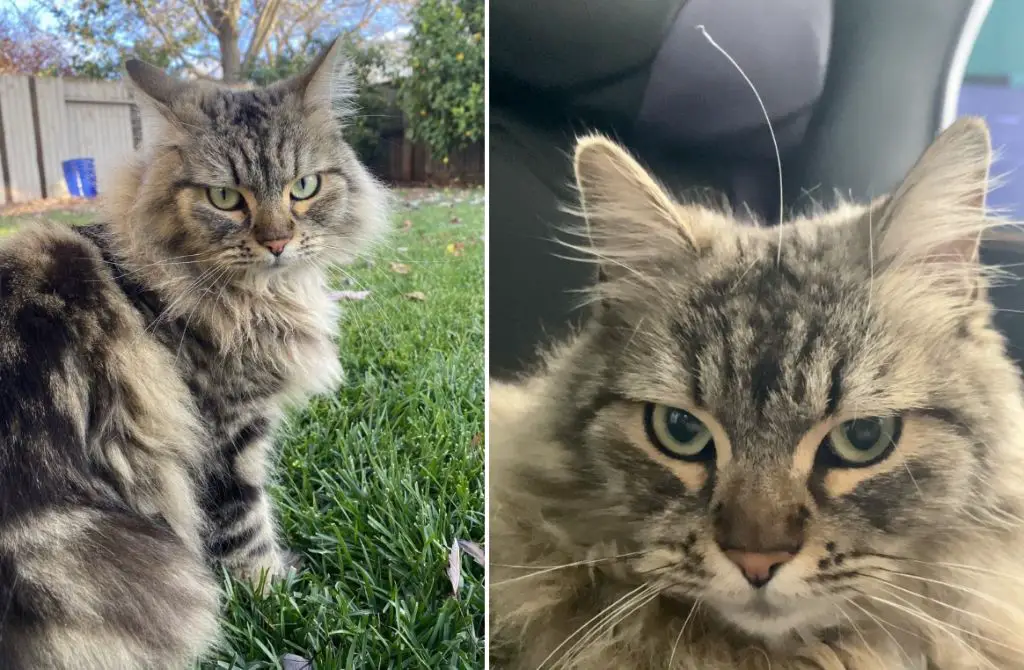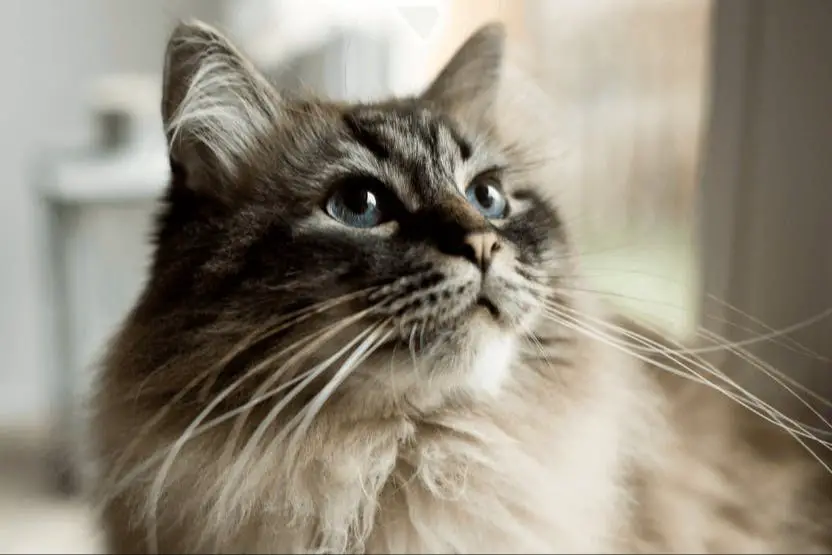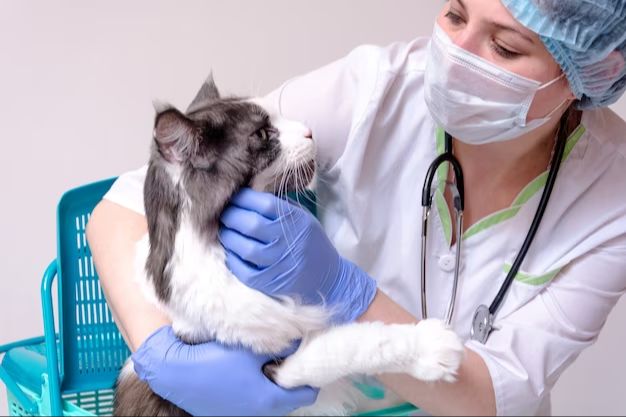Cat whiskers, also known as vibrissae, are the long, stiff hairs protruding from a cat’s face around their muzzle, above their eyes, and on their forelegs. They serve many sensory purposes for cats, helping them navigate their environment and detect movements and objects around them. Cat whiskers are naturally shed and regrow over time, but sometimes whiskers may fall out excessively due to underlying medical conditions.
This article will provide an overview of cat whiskers, whether they are supposed to fall out naturally, signs of abnormal whisker loss, potential causes, and how to care for a cat experiencing excessive whisker loss.
What are Cat Whiskers?
Cat whiskers are specialized hairs that grow from the cat’s face around their muzzle, above the eyes, and on the chin. They are thicker, longer, and more rigid than the cat’s normal fur. The whiskers are embedded more deeply in the cat’s skin and connect to blood vessels and nerve endings at their base that send sensory signals to the brain.

Whiskers act as sensing devices for a cat, helping it determine whether openings and gaps are large enough for the cat’s body to fit through. The width of the whiskers is about the same as the cat’s shoulder width, so they can tell if the cat’s body will be able to pass through an opening by whether the whiskers can fit. Whiskers also help cats detect changes in air currents, which helps their hunting abilities. The whiskers pick up subtle vibrations in the air that alert the cat to movements and objects around them even when it is too dark for them to see.
Whiskers are essential for spatial awareness and navigation. They help the cat perceive the environment around them and move through it safely and effectively even in darkness. The sensory input from whiskers is processed in the cat’s brain to create a complex spatial map and enable the cat to position and maneuver its body precisely. Overall, whiskers serve as an important sensory system that supplements vision and aids cats in hunting, movement, and awareness of their surroundings.[1]
Whiskers are made of keratin, the same protein that makes up hair and fingernails in humans. The follicles that produce cat whiskers are highly sensitive and well supplied with nerves and blood vessels, making them excellent sensory tools.[2]
Do Cat Whiskers Fall Out Naturally?
Yes, it is completely normal and natural for cat whiskers to fall out over time. Just like regular hair, whiskers go through a natural growth cycle. Each individual whisker will fall out and be replaced by a new one every few months. This occurs as part of the regular whisker growth process and allows the follicle to produce a fresh, new whisker.
Cats do not rely on their whiskers for balance or spatial awareness like some people believe. So when whiskers fall out, cats adjust easily and the new whiskers provide the same sensory input. According to veterinarians, losing a few whiskers at a time is not a cause for concern for cats 1. As long as whiskers are being shed at a normal rate, the cat’s body will produce replacements on its own.
In summary, whiskers falling out is a natural part of a cat’s regular growth cycle. As with shedding fur, cats naturally lose whiskers and regrow new ones to replace them over time. So there is no need to worry if you notice a whisker or two has fallen out.
How Often Do Cat Whiskers Fall Out?
Cat whiskers go through a natural growth and shedding cycle. Typically, a cat will only lose one or two whiskers at a time as new ones grow in to replace them. According to experts, each individual whisker will fall out every couple of months as part of this cycle. The whiskers on a cat’s face are not all synchronized, so at any given time some will be falling out while others are actively growing. This helps ensure the cat always maintains its full set of whiskers.

It’s completely normal for cats to shed old whiskers and regrow new ones. Most cats will not even notice when they lose a whisker or two. The whiskers provide important sensory information, so the new growth replaces the old continuously. As long as your cat is not showing signs of excessive whisker loss beyond the normal shedding rate, there is no cause for concern.
Source: https://wagwalking.com/wellness/why-do-my-cats-whiskers-fall-out
Signs of Abnormal Whisker Loss
Cat whiskers don’t usually fall out unless there is an underlying health issue. Some signs that may indicate abnormal whisker loss include:
Patches of missing whiskers – Healthy cats typically lose whiskers evenly on both sides of the face. Seeing bald patches or large areas of missing whiskers likely signals a health problem.
Inflammation around follicles – Look for signs of redness, irritation or pus around empty whisker follicles, which can indicate infection or skin disease.
Breakage near the base – Whiskers that have broken mid-shaft rather than shedding naturally at the follicle may indicate nutritional deficiency or stress.
Rapid whisker loss – Shedding many whiskers within a short span of time is not normal. This may signal illness, stress or self-trauma due to behavioral issues.
One-sided whisker loss – Losing whiskers mostly on just one side of the face is considered abnormal and warrants a veterinary visit to diagnose potential underlying causes.
Overall lackluster coat – Significant whisker loss sometimes accompanies a dull, brittle coat and skin problems, signaling systemic health issues.
Noticing any of these signs means it’s time for a veterinary exam to get to the root of what’s causing your cat’s excessive whisker loss.
Common Causes of Abnormal Whisker Loss
There are several common conditions that can lead to abnormal whisker loss in cats:

Stress – Stress, anxiety, and abnormal obsessive grooming behaviors can cause cats to overgroom and pull out their whiskers. This may happen with changes in environment, introduction of new pets, or other stressors.
Malnutrition – Nutritional deficiencies, particularly low protein diets, can lead to poor coat and whisker health. Whiskers may fall out more readily in malnourished cats.
Skin Infections – Bacterial infections like ringworm or staph can cause inflammation of hair follicles leading to whisker loss. Fungal infections may also damage the follicles. https://www.catster.com/guides/cat-losing-whiskers/
Allergies – Allergies that cause itching, skin irritation, and hair loss can also lead to excess whisker loss as cats scratch and overgroom.
Underlying Disease – Serious diseases like kidney failure, hyperthyroidism, cancer, and autoimmune disease can sometimes cause poor coat quality and whisker loss.
Trauma – Injury to the face, rough play, burns, or other trauma can damage whisker follicles and lead to temporary or permanent whisker loss.
Diagnosing the Cause of Excessive Whisker Loss
If your cat is losing more whiskers than normal, the first step is to take them to the vet for an examination. The vet will perform a complete physical exam and ask about your cat’s health history to try to pinpoint the cause.
They will look for any signs of infection, inflammation, trauma, stress, or allergies that could be making your cat overgroom or pull out whiskers. The vet may take skin scrapings or samples of discharge to check for ringworm, mites, bacterial or fungal infections under a microscope.
Bloodwork can identify underlying illness causing whisker loss like hyperthyroidism or kidney disease. The vet may also recommend allergy testing or trial treatments for potential allergies. Diagnostic imaging like X-rays or ultrasound can check for internal issues like dental disease or tumors.
If the cause remains unclear after the initial workup, the vet may recommend keeping a symptom diary, videotaping behavior at home, or referring you to a veterinary dermatologist for specialized testing. Getting to the root cause is important to properly treat excessive whisker loss in cats.
For more information, see this reference: https://lincolnwayvet.com/blog/whisker-loss-in-cats/
Treating Excessive Whisker Loss
The treatment for excessive whisker loss will depend on identifying and addressing the underlying cause. Some common treatments include:

If stress or anxiety is causing overgrooming and whisker loss, try to minimize stressful triggers and make the home environment more relaxing for your cat. Medications or pheromone products may help reduce anxiety. Provide more vertical territory and hiding spots to decrease conflict with other household pets. Increase play, exercise and interaction to boost happiness.
For allergies or skin irritation, treat the allergy itself through diet change, medications or allergen avoidance. Steroids or anti-itch drugs can provide relief as well. Keeping the skin clean and applying moisturizers can aid healing.
For parasites like mites, prescription anti-parasitic medications will kill the mites. Topicals like Revolution treat both mites and fleas. Steroids help control itching while parasites are eliminated.
For bacterial or fungal infections, antibiotics or antifungals prescribed by a vet will clear up the infection and allow whiskers to regrow. Keeping skin clean and dry helps prevent secondary infections.
For dental issues or abscesses, professional dental cleanings and tooth extractions can resolve oral pain and overgrooming. Antibiotics may be prescribed as well.
For trauma or injuries, whiskers should regrow on their own once swelling and wounds have healed, as long as the follicle itself is intact. Pain medication can help recovery.
In some cases, regrowth of healthy whiskers happens on its own once the underlying condition is resolved and inflammation is reduced. Patience and supportive care helps facilitate regrowth.
If an underlying cause cannot be identified, your veterinarian may prescribe medications to reduce self-grooming behavior and allow whiskers time to recover.
The key is diagnosing and properly treating whatever problem is causing your cat distress and overgrooming in the first place. This will create the ideal conditions for whisker regrowth.
Caring for a Cat Losing Whiskers
If your cat is losing more whiskers than normal, there are some things you can do to care for them and minimize stress:
Provide a calm, reassuring environment. Losing whiskers can be alarming for cats, so try to maintain their normal routine and avoid any major changes that could cause additional stress.
Check for sources of irritation. Look for any irritants in their environment, like new cleaning products or perfumes, and remove them. Gently examine their face and head to make sure there are no sores or irritations causing whisker loss.
Brush them regularly. Gentle brushing distributes natural oils through the fur and may stimulate healthy follicle growth. It’s also soothing for a stressed cat.
Use a pheromone diffuser. Facial pheromones are believed to stimulate follicle growth. A synthetic pheromone like Feliway may help whiskers regrow.
Limit stressors. While whiskers are growing back, avoid handling their face and minimize things that may be stressful or overstimulating.
Be patient as they regrow. It takes weeks to months for whiskers to fully regrow. Offer support during this process and avoid rushing regrowth.
If whisker loss persists or causes obvious stress, talk to your vet. They can recommend care to make your cat more comfortable as their whiskers grow back.
Conclusion
In summary, it is normal for cats to shed some whiskers periodically as part of their natural growth cycle. However, excessive or abnormal whisker loss can indicate an underlying health issue. Some of the common causes of abnormal whisker loss include skin infections, allergies, stress, malnutrition, and hormonal imbalances. If your cat is losing more whiskers than seems normal or is showing other signs of illness, it’s a good idea to take them to the vet for an examination. The vet can help diagnose the cause of the excessive whisker loss and recommend appropriate treatment options. With proper care and treatment, your cat can recover and regain their beautiful whiskers.

